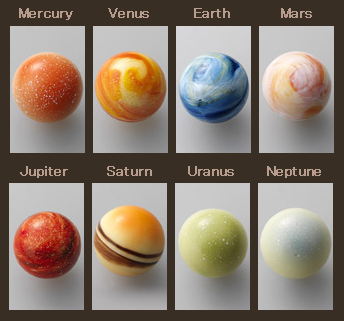Chocolate. Planets. Two of my favorite things. Together. My brain might explode any moment. How did it take someone so long to think of a chocolate solar system? And why isn't it sold in every grocery store?
This beautiful edible set of Chocolate Planets is available in Japan, though created by L'Eclat, a very French-sounding company which actually isn't French; it's a minor confection subsidiary of a Japanese chain of luxury hotels. So, if you want to eat these, you need to win the lottery and go stay in Osaka.

Chocolate Solar System
And, if Google translations are to be trusted, you can read their best guesses in English to review the flavor of each planet. For those of you averse to clicking around through foreign languages other than English, they are:
Mango coconut Mercury, lemon creme Venus, cocoa Earth, orange praline Mars, vanilla Jupiter, rum raisin Saturn, milk Uranus, and cappuccino Neptune.
The flavors have changed for the year 2012, and the site also noted the previous flavors. Somehow, I expected Jupiter to be a cherry swirl.

Chocolate Planets. And it's about time.
Also in 2012, L'Eclat has introduced a brand new line of Chocolate Meteorites! So very clever. Again, Google Translator is a fine tool for reading the entire meteorite page, and the accompanying flavors of the extra-terrestrial space rocks.
These confections are modeled after genuine meteorites found on various continents through the last two centuries. Because we needed chocolates shaped as chondrites. This truly opens up tremendous possibilities, both for culinary novelties and for education. Up to now the cleverest thing I think I've seen are gummy space shuttles, which are sold in various spots in Houston. We need more space foods!

Chocolate Meteorites
However... poor Pluto, utterly unrepresented. Demoted to the kiddie table once again. Perhaps someday we'll see another set with Eris, Pluto, Makemake, Ceres, Sedna and all the other potential dwarf planets! Wouldn't that be a more fun way to learn them?


































































